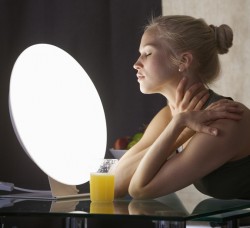Light Therapy
Seasonal affective disorder, also abbreviated as SAD, is a type of depression that occurs when the amount of natural light you are exposed to is reduced. This type of depression usually occurs during the fall and winter seasons due to shorter days. If you suffer from seasonal affective disorder, spending segments of time immersed in full-spectrum light can reduce the severity of your symptoms.
What is Light Therapy?
Light therapy was first introduced in the early 1980s by the National Institute of Mental Health. To date, approximately 2,000 individuals with seasonal affective disorder (SAD) have participated in clinical trials examining the effects of light therapy in the treatment of this condition. Psychiatrists, family physicians and psychologists have used this form of therapy to treat depression-related conditions like SAD for few years. More and more clinicians have started to offer light therapy as an alternative to traditional drug treatments or psychotherapy.
Light therapy involves exposing you to concentrated levels of light. During light therapy, a set of fluorescent bulbs are installed in a box with a diffusing screen and placed on a table. You are then asked to sit at the table, near the light box. The lights are on and your eyes are open during this time. It is not recommended that you look directly at the lights; instead you are encouraged to read, write and/or eat a meal. It is important to angle your head and body towards the lights and focus on activities illuminated by the lights and not necessarily on the lights themselves.
Sessions typically last from 15 minutes to three hours, once or twice a day, but this time frame depends on your needs and the equipment used during the treatment process. It is important that the level of light produced match the level of natural outdoor light that occurs before sunset or immediately following sunrise. Light intensity is determined by immersing you in various amounts of light and then observing and documenting your responses to the different light levels.
If you suffer from winter depression, treatment is (generally) most effective during the morning hours, preferably upon awakening. While morning light is preferable, in this case, you may actually do better with evening light. A light therapist can help you determine what time of the day is best for you.
Does Light Therapy Successfully Reduce or Eliminate SAD?

Light therapy uses special lights to help alleviate the symptoms of SAD.
Light therapy has proven effective when treating individuals who have suffered with SAD for at least 3 years. Individuals with this condition noticed significant symptom reductions during the first week of treatment. In addition, these individuals noticed that their symptoms returned, rather quickly, when the lights levels were reduced. Therefore, it is important that the treatment be applied consistently beginning in the fall or winter and continued until the end of April.
Once the spring season hits there is usually enough outdoor light to maintain your hormone levels, stabilize your moods and preserve your energy levels. In some cases, you may be able to reduce your treatments to one to three days a week, without experiencing negative effects, but it is important to remember that the majority of individuals with this condition start to plummet once treatment is interrupted.
What Side Effects Are Associated With Light Therapy?
There appears to be minimal side effects associated with light therapy. You may experience mild side effects such as headaches, eye strain, eye irritation, nausea at the beginning of treatment. These side effects typically diminish with continued usage. While rare, there is a chance that you may experience more severe side effects such as sleep irregularities, restlessness, irritability and/or a feeling of being intoxicated or “high.”
If you experience eye irritation that persists with continued usage, your light therapist will have you sit farther away from the lights, sit under the lights for shorter amounts of time or install a humidifier in the treatment room. If you experience a visual glare under light therapy, you therapist will alleviate this side effect by using a tilted light box design.
While there does not appear to be adverse side effects associated with light therapy in pregnant women, it is important to note that light therapy has not been effectively evaluated in pregnant women. Nevertheless, clinical trials are currently being conducted in in Connecticut, New York and Ohio to examine these effects in pregnant women. These clinical trials examine a variety of interventions for postpartum depression, regardless of whether or not the depression is related to fall and winter seasons.
References:
Ilardi, S. S. (2010). The Depression cure: The 6-Step program to beat depression without drugs. Cambridge, MA: Da Capo Press.
Rosenthal, N. E. (2005). Winter blues, revised edition: Everything you need to know to beat seasonal affective disorder. New York, NY: Guilford Press.





